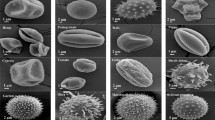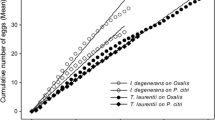Abstract
Plant pollen is considered a food of high nutritional quality for several natural enemies, such as predatory insects and mites. In periods of prey absence or scarcity, omnivorous predators often exploit plant pollen as an alternative food. In the case of predators feeding on mixed diets, pollen may be consumed supplementary to the main prey. However, genetic variation may translate into quality differences in pollen derived from distinct plant species. We herein assessed the nutritional suitability of the pollen of four anemophilous plant species [cattail—Typha latifolia (L.), pine, corn, and olive] for the predatory mite Amblydromalus limonicus (Garman & McGregor) (Acari: Phytoseiidae), a phytoseiid mite with great potential for controlling thrips and whiteflies in greenhouse crops. Juvenile development and survival were not affected by the different pollens. Nevertheless, significant differences in adult performance (longevity and egg production) resulted in considerable effects of pollen species on the calculated intrinsic rates of increase (rm) for this predator. Cattail followed by olive pollen resulted in the highest rm values (0.2340 and 0.2001 day−1, respectively), while the lowest values were recorded for corn and pine pollen. Our results show that all pollens tested may be used as alternative food for sustaining the population of A. limonicus in the field. Recorded differences among pollens highlight the need for a careful consideration of the quality of pollen used in laboratory rearings and in field applications.

Similar content being viewed by others
References
Birch LC (1948) The intrinsic rate of natural increase of an insect population. J Anim Ecol 17:15–26
Broufas GD, Koveos DS (2000) Effect of different pollens on development, survivorship and reproduction of Euseius finlandicus (Acari: Phytoseiidae). Environ Entomol 29:743–749
Broufas GD, Koveos DS (2001) Cold hardiness characteristics in a strain of the predatory mite Euseius (Amblyseius) finlandicus (Acari: Phytoseiidae) from Northern Greece. Ann Entomol Soc Am 94:82–90
Broufas GD, Pappas ML, Koveos DS (2007) Development, survival, and reproduction of the predatory mite Kampimodromus aberrans (Acari: Phytoseiidae) at different constant temperatures. Environ Entomol 36:657–665
Coll M, Guershon M (2002) Omnivory in terrestrial arthropods: mixing plant and prey diets. Annu Rev Entomol 47:267–297
Denno RF, Fagan WF (2003) Might nitrogen limitation promote omnivory among carnivorous arthropods? Ecology 84:2522–2531
Eubanks MD, Styrsky JD (2005) Effects of plant feeding on the performance of omnivorous predators. In: Wäckers FL, van Rijn PCJ, Bruin J (eds) Plant-provided food for carnivorous insects: a protective mutualism and its applications. Cambridge University Press, Cambridge, UK, pp 148–177
Gerson U, Smiley RL, Ochoa R (2003) Mites (Acari) for pest control. Oxford Blackwell Science, Oxford, UK
Goleva I, Zebitz CPW (2013) Suitability of different pollen as alternative food for the predatory mite Amblyseius swirskii (Acari, Phytoseiidae). Exp Appl Acarol 61:259–283
Hoogerbrugge H, van Houten Y, Knapp M, Bolckmans K (2011) Biological control of thrips and whitefly on strawberries with Amblydromalus limonicus and Amblyseius swirskii. IOBC/WPRS Bull 68:65–69
Hoy MA (2011) Agricultural acarology: introduction to integrated mite management. CRC Press, Boca Raton, USA
Huang N, Enkegaard A, Osborne LS, Ramakers PMJ, Messelink GJ, Pijnakker J, Murphy G (2011) The banker plant method in biological control. Crit Rev Plant Sci 30:259–278
Hulshof J, Ketoja E, Vänninen I (2003) Life history characteristics of Frankliniella occidentalis on cucumber leaves with and without supplemental food. Entomol Exp Appl 108:19–32
Knapp M, van Houten Y, Hoogerbrugge H, Bolckmans K (2013) Amblydromalus limonicus (Acari: Phytoseiidae) as a biocontrol agent: literature review and new findings. Acarologia 53:191–202
Kolokytha PD, Fantinou AA, Papadoulis GT (2011) Effect of several different pollens on the bio-ecological parameters of the predatory mite Typhlodromus athenas Swirski and Ragusa (Acari: Phytoseiidae). Environ Entomol 40:597–604
Leman A, Messelink G (2015) Supplemental food that supports both predator and pest: a risk for biological control? Exp Appl Acarol 65:511–524
Lorenzon M, Pozzebon A, Duso C (2012) Effects of potential food sources on biological and demographic parameters of the predatory mites Kampimodromus aberrans, Typhlodromus pyri and Amblyseius andersoni. Exp Appl Acarol 58:259–278
McMurtry JA, Croft BA (1997) Life-styles of phytoseiid mites and their roles in biological control. Annu Rev Entomol 42:291–321
McMurtry JA, de Moraes GJ, Sourassou NF (2013) Revision of the lifestyles of phytoseiid mites (Acari: Phytoseiidae) and implications for biological control strategies. Syst Appl Acarol 18:297–320
Messelink GJ, van Steenpaal SEF, Ramakers PMJ (2006) Evaluation of phytoseiid predators for control of western flower thrips on greenhouse cucumber. BioControl 51:753–768
Messelink GJ, Bennison J, Alomar O, Ingegno BL, Tavella L, Shipp L, Palevsky E, Wäckers FL (2014) Approaches to conserving natural enemy populations in greenhouse crops: current methods and future prospects. BioControl 59:377–393
Meyer JS, Ingersoll CG, McDonald LL, Boyce MS (1986) Estimating uncertainty in population growth rates: jackknife vs. bootstrap techniques. Ecology 67:1156–1166
Nguyen DT, Vangansbeke D, De Clercq P (2015) Performance of four species of phytoseiid mites on artificial and natural diets. Biol Control 80:56–62
Nomikou M, Janssen A, Schraag R, Sabelis MW (2002) Phytoseiid predators suppress populations of Bemisia tabaci on cucumber plants with alternative food. Exp Appl Acarol 27:57–68
Nomikou M, Janssen A, Sabelis MW (2003) Phytoseiid predators of whiteflies feed and reproduce on non-prey food sources. Exp Appl Acarol 31:15–26
Roulston TH, Cane JH (2000) Pollen nutritional content and digestibility for animals. Plant Syst Evol 222:187–209
Roulston TH, Cane JH, Buchmann SL (2000) What governs protein content of pollen: pollinator preferences, pollen–pistil interactions, or phylogeny? Ecol Monogr 70:617–643
Sabelis MW, van Rijn PCJ, Janssen A (2005) Fitness consequences of food-for-protection strategies in plants. In: Wäckers FL, van Rijn PCJ, Bruin J (eds) Plant-provided food for carnivorous insects: a protective mutualism and its applications. Cambridge University Press, Cambridge, UK, pp 109–134
Schmidt JM, Peterson JA, Lundgren JG, Harwood JD (2013) Dietary supplementation with pollen enhances survival and Collembola boosts fitness of a web-building spider. Entomol Exp Appl 149:282–291
Sokal RR, Rohlf FJ (1995) The principles and practice of statistics in biological research, 3rd edn. Freeman, New York, USA
Southwood TRE, Henderson PA (2000) Ecological methods, 3rd edn. Blackwell, Oxford, UK
SPSS (2011) SPSS. IBM SPSS statistics base 20, ©copyright IBM Corporation
Swirski E, Dorzia N (1968) Studies on the feeding, development and oviposition of the predaceous mite Amblyseius limonicus Garman and McGregor (Acarina: Phytoseiidae) on various kinds of food substances. Isr J Agric Res 18:71–75
van Houten YM, van Rijn PCJ, Tanigoshi LK, van Stratum P, Bruin J (1995) Preselection of predatory mites to improve year-round biological control of western flower thrips in greenhouse crops. Entomol Exp Appl 74:225–234
van Houten YM, Rothe J, Bolckmans KJF (2008) The generalist predator Typhlodromalus limonicus (Acari: Phytoseiidae): a potential biological control agent of thrips and whiteflies. IOBC/WPRS Bull 32:237–240
van Rijn PCJ, Tanigoshi LK (1999) Pollen as food for the predatory mites Iphiseius degenerans and Neoseiulus cucumeris (Acari: Phytoseiidae): dietary range and life history. Exp Appl Acarol 23:785–802
van Rijn PCJ, van Houten YM, Sabelis MW (1999) Pollen improves thrips control with predatory mites. IOBC/WPRS Bull 22:209–212
van Rijn PCJ, van Houten YM, Sabelis MW (2002) How plants benefit from providing food to predators even when it is also edible to herbivores. Ecology 83:2664–2679
Vangansbeke D, Nguyen DT, Audenaert J, Verhoeven R, Deforce K, Gobin B, Tirry L, De Clercq P (2014a) Diet-dependent cannibalism in the omnivorous phytoseiid mite Amblydromalus limonicus. Biol Control 74:30–35
Vangansbeke D, Nguyen DT, Audenaert J, Verhoeven R, Gobin B, Tirry L, De Clercq P (2014b) Performance of the predatory mite Amblydromalus limonicus on factitious foods. BioControl 59:67–77
Vangansbeke D, Nguyen DT, Audenaert J, Verhoeven R, Gobin B, Tirry L, De Clercq P (2015) Supplemental food for Amblyseius swirskii in the control of thrips: feeding friend or foe? Pest Manage Sci. doi:10.1002/ps.4000
Wäckers FL (2005) Suitability of (extra-) floral nectar, pollen, and honeydew as insect food sources. In: Wäckers FL, van Rijn PCJ, Bruin J (eds) Plant-provided food for carnivorous insects: a protective mutualism and its applications. Cambridge University Press, Cambridge, UK, pp 17–74
Acknowledgments
The editor and two anonymous reviewers are acknowledged for their constructive comments on an earlier version of our manuscript. Vassiliki Mantali, Anneta Triantafyllou and Georgia Tavlaki are thanked for technical assistance during the course of the experiments. K. Samaras and M.L. Pappas were supported by the Onassis Public Benefit Foundation.
Author information
Authors and Affiliations
Corresponding author
Additional information
Handling Editor: Patrick De Clercq.
Rights and permissions
About this article
Cite this article
Samaras, K., Pappas, M.L., Fytas, E. et al. Pollen suitability for the development and reproduction of Amblydromalus limonicus (Acari: Phytoseiidae). BioControl 60, 773–782 (2015). https://doi.org/10.1007/s10526-015-9680-5
Received:
Accepted:
Published:
Issue Date:
DOI: https://doi.org/10.1007/s10526-015-9680-5




